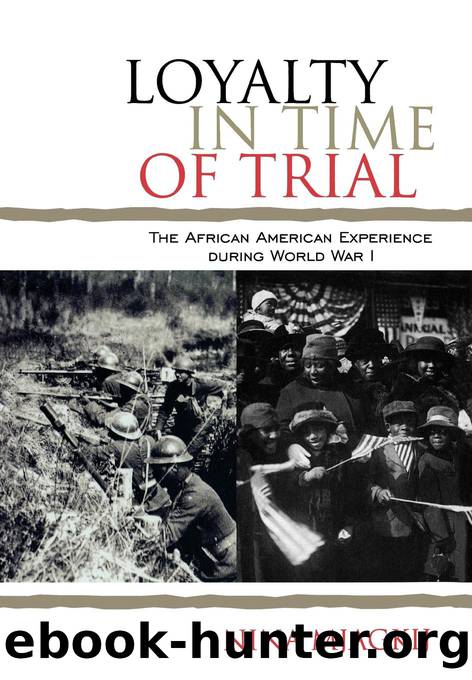Loyalty in Time of Trial by Mjagkij Nina;Moore Jacqueline M.;Mjagkij Nina;

Author:Mjagkij, Nina;Moore, Jacqueline M.;Mjagkij, Nina;
Language: eng
Format: epub
Publisher: Rowman & Littlefield Publishers
Published: 2011-08-15T00:00:00+00:00
Photo 5.1 YMCA huts in France were popular destinations for the black troops, particularly the labor battalions who were not serving in the line of of fire. Source: Kautz Family YMCA Archives, University of Minnesota, Minneapolis
The 369th was the first black combat regiment that arrived in France. The regiment, which had trained at Camp Wadsworth, South Carolina, had been quickly dispatched overseas after racial tensions had escalated between black soldiers and white residents of Spartanburg in the fall of 1917. However, the menâs journey to France was anything but quick. Following their departure from Spartanburg on October 24, 1917, they reached New York City, where they were quartered in several armories and tents set up in a city park. On November 11, the 369th received orders to board the transport ship Pocahontas. But only one day into the journey, the ship had to return to port due to engine problems. The men disembarked and reported to Camp Merritt, New Jersey, where they remained for the next three weeks until their ship was repaired. On December 2, they boarded the Pocahontas once again, but a fire on the ship kept the troops in port for eleven days. On December 13, when the men made their third attempt to sail to France, their ship collided with a British oil tanker. This time, however, military officials decided to let the soldiers repair the ship en route and the regiment finally left the United States the following day.
The 369th landed in France on January 1, 1918. Upon the regimentâs arrival, the men were assigned to perform labor duties and to guard a German prisoner of war camp. Since the War Department had assured the black soldiers that they would serve in arms at the front, troop morale began to crumble. Embarrassed by their work detail, some of the men fabricated elaborate stories of their battle participation in the letters they wrote home. However, morale picked up when the men learned of their assignment to the front. In March 1918, General John J. Pershing, commander of the American Expeditionary Force (AEF) in Europe, responded to French requests for troop reinforcements and transferred the 369th to the French Army. Some contemporaries speculated that Pershingâs decision was the product of political pressure, rather than racism. After all, Pershing had a long history of working and serving with African Americans. Following his graduation from high school in 1878, Pershing had taught at a black school in his hometown Laclede, Missouri. But by 1882 he had discovered a penchant for the military and left Missouri to enroll in the U.S. Military Academy at West Point, New York. After four years of studies, he graduated and the Army assigned him to cavalry service in the West. In 1896 Pershing took charge of the all-black Tenth Cavalry, the so-called Buffalo Soldiers, which earned him the nickname âNigger Jackâ in military circles. Reporters changed the offensive nickname to the moniker âBlack Jackâ when Pershing led the Tenth Cavalry into battle during the Spanish-American War.
Download
This site does not store any files on its server. We only index and link to content provided by other sites. Please contact the content providers to delete copyright contents if any and email us, we'll remove relevant links or contents immediately.
The Radium Girls by Kate Moore(11663)
100 Deadly Skills by Clint Emerson(4719)
The Templars by Dan Jones(4567)
Rise and Kill First by Ronen Bergman(4565)
The Doomsday Machine by Daniel Ellsberg(4272)
The Rape of Nanking by Iris Chang(4040)
Killing England by Bill O'Reilly(3904)
Hitler in Los Angeles by Steven J. Ross(3814)
Stalin by Stephen Kotkin(3739)
12 Strong by Doug Stanton(3428)
Hitler's Monsters by Eric Kurlander(3182)
Blood and Sand by Alex Von Tunzelmann(3073)
Darkest Hour by Anthony McCarten(3026)
The Code Book by Simon Singh(2887)
The Art of War Visualized by Jessica Hagy(2849)
Hitler's Flying Saucers: A Guide to German Flying Discs of the Second World War by Stevens Henry(2642)
Babylon's Ark by Lawrence Anthony(2448)
The Second World Wars by Victor Davis Hanson(2432)
Tobruk by Peter Fitzsimons(2387)
